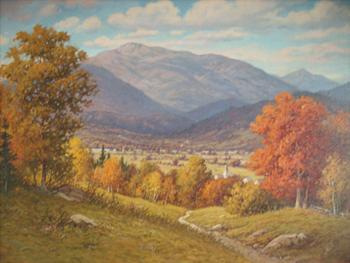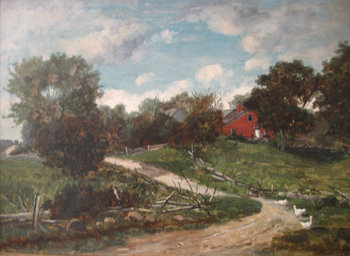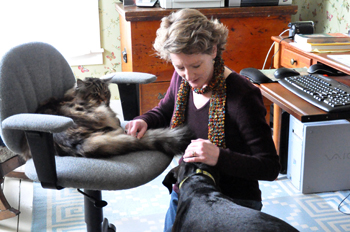
Andrea Melville '79 moves from acting to producing artful television
Sitting in the living room of her comfortable old house in Vermont, Andrea Melville '79 doesn't mind struggling a bit to travel back in time. It's been three decades since she had her own key to the Sawyer Fine Arts Center and spent many of her days and nights there. In some ways her experiences there set the stage for her current work.
“I was into theater and dance in high school and couldn't imagine doing anything else,” she says. “Even at summer camp I did plays and danced.” Her mother converted the barn of their home in Hampton Falls, N.H., into a studio, where she taught painting to children and adults. Melville says, “I had that visual interest, too—painting, water colors, oils.”
When it was time for college, Melville wasn't drawn to the large public “factory” kind of education that most of her peers were interested in. “I wanted something small and close to the mountains, so when I was accepted at Colby-Sawyer, it was like, whoa, a three-year B.F.A. program with professional connections to summer stock (theater); I should go.”
On a campus with 800 mostly female students, Melville worked one-on-one with actors, choreographers and dancers who were also her professors, people such as Joel Conrad, Sally Draper and Eugene Youngken. She was involved in nearly every theater and dance production from 1976 to 1979, including “Three Penny Opera” in the role of a young maid in “Blithe Spirit,” and she designed costumes and sets for many more.
“The most important thing I learned is to be versatile—acting, singing and dancing in many different styles is important,” she says, “but I was also very involved with the technical aspects of mounting a show: stage management, design, lighting and sound. Even if you don't physically do all of those jobs in a production, it really helps to understand the entire package, what goes into putting together a production. You learn to appreciate the importance of every job and the meaning of working together. When it all works together, it's amazing.”
The summer after graduation, Melville was cast in “Fiddler on the Roof” and “Brigadoon” at Prescott Park in Portsmouth, N.H., and that fall she joined The Looking Glass Theater Company in Providence, R.I., which performed in schools around New England. But like many talented and ambitious actors, she soon gravitated to the brightest lights, the biggest city.
“I met a couple of actors from New York City, so at the time I said, okay, this is what you're supposed to do,” she says. She moved to the city and waited tables while auditioning for roles, the local custom for aspiring actors, and she picked up extra work in soap operas and films. While she enjoyed acting, she grew more curious about what was happening behind the camera.
“In high school and at Colby-Sawyer I had done a lot of technical work, building of sets, so one summer in New York I did a crash course in how to use a camera and edit video. Then I started getting a lot of jobs—assistant director of a soap opera, crowd control on film,” Melville explains. “When I worked on 'As the World Turns,' I was amazed because it took approximately 75 people who had to do their jobs well, every day. Even though it was a soap opera, I was very proud of the experience.”
After eight years in the city, Melville decided she had had enough. “It was great, and I miss all the theater and the great restaurants,” she says, “but I didn't want to become a city person.” She began sending out her résumé and was hired by New Hampshire Public Television (NHPTV) in the mid-1980s as assistant producer for its “New Hampshire Crossroads” and “First in the Nation” programs. She wrote scripts, set up shoots and coordinated crews—all that goes into telling stories for television. For the tenth anniversary of “New Hampshire Crossroads,” she and a crew traveled to Old Hampshire County in England to explore the region where New Hampshire's founders lived. They traveled the countryside, filming the reconstruction of a thatched roof and the beguiling game of cricket, and their discovery of the grave sites of some of New Hampshire's founding fathers.
While at NHPTV, Melville won two Emmy Awards from the National Academy of Television Arts and Science's Boston/New England Chapter for two documentaries she produced. One was about the New Hampshire Festival Orchestra's production of Aaron Copeland's “Appalachian Spring” and the other was based on Superman's death in the comics and allure in contemporary culture, performed by the New Hampshire Symphony Orchestra. “All the producers on “New Hampshire Crossroads” had personal interests—mine were theater, dance and music—and hiking,” she says, laughing. “It was great because we could tailor a lot of our stories to our interests.”
Melville also met her husband, Bill Marcinkowski, at NHPTV, and they married in 1993. They eventually moved to their current home in Northfield, Vt., and Melville was hired by Vermont Public Television as the producer for two programs, “In the Public Interest,” and “Rural Free Delivery,” a 30-part series that attracted some of the station's highest ratings. She continued at VPT after the birth of their son Adam, but after a second child, Dylan, she cut back to a part-time fund-raising job. In 2006, while she and her family were visiting friends on the New Hampshire seacoast, she experienced a quiet epiphany that took her in a direction for which her life had been preparing her.

Island Magic
From their friends' home in Rye, N.H., Melville looked out over the ocean one morning to the Isles of the Shoals, a place she had often visited on high school trips and had always wanted to take her family. Finally, it was the right time to go.
“It was a perfect June day, not too windy, not too hot; the ocean was like a mirror going out,” she said. “We had such a blast walking around on the rocks. This feeling came over me that this would be a great documentary—all the history and the funky stories and the beautiful location—but I figured someone had probably already done it.”
While waiting for the ferry, Melville stopped at the gift shop to inquire about a documentary of the Isles of Shoals. The woman told her no, they didn't have one, but they probably should because people ask for it all the time. Melville later contacted the executive director of the Star Island Corporation, which owns the largest islands in the Shoals, about her idea and received an enthusiastic response. She wrote a treatment outlining the film and applied for and received grants from the New Hampshire Humanities Council and Arts Council.
“I said, 'Okay, this is it, I gotta do it,' and I quit my job, and my husband's freakin' out!” Melville recalls says, laughing. “I had raised some money, certainly not all I needed, but I always knew I could do it.”
Over the next two years, Melville researched the Shoals' history and visited as often as she could the next spring, summer and fall, filming about 30 days on nearly all of the nine islands with a borrowed video camera and tripod. “I would drive down (from Vermont) the night before and crash at my father's house and jump on the boat the next morning,” she says.
By 2008, she had produced “An Island Kingdom: A Documentary Featuring the 400 Year History of The Isles of Shoals,” with her new company, Barking Spider Productions. The film begins with Captain John Smith's discovery of tiny granite islands ten miles off the coast of New Hampshire and Maine, which he found barren and yet beautiful and surrounded by fertile fishing grounds. He mapped the isles, named them for himself and claimed them for England. From 1640 to 1680, some 600 fishermen inhabited the isles in their heyday as the center of New England's fishing industry. By the late 19th century, the fishing business had been largely replaced by a thriving tourist industry, with big hotels cropping up on the islands. Writer and artist Celia Thaxter established an artists' salon at her family's hotel on Appledore Island, which attracted many of the era's artists, writers and musicians.
In her production notes, Melville writes of the “island magic” that draws people back time and again. The magic surrounded her as well when she ran into a college classmate, Jennifer Nye '79, on Star Island, whom she hadn't seen in 30 years, and again, when she connected with Celia Hubbard, who agreed to read passages for the film from Among the Isles of Shoals, a book written by the woman she was named after, her great-great-great grandmother, Celia Thaxter. Melville knew she was fated to produce this film when her father showed her their family tree, which revealed that Sophia Peabody—wife of 19th-century writer Nathaniel Hawthorne who had published, after his death, his diary of a visit to the Isles of Shoals and Celia Thaxter's salon was the daughter of Melville's great-grandmother's sister.
In “An Island Kingdom,” which was nominated for an Emmy, Melville brings watercolor and oil paintings, poetry and prose, photography, film and period music together to set the scenes across time of the Isles of Shoals. It's a captivating story full of old island magic.

Mountain Majesty
While filming some of the original paintings for “An Island Kingdom” at Banks Gallery in Portsmouth, Melville came across stunning 19th-century paintings of the White Mountains in northern New Hampshire. She learned that the works were representative of The White Mountain School of Art, a loosely connected but influential group of artists and writers who brought the region's wild beauty and grandeur into the young nation's consciousness. Before she finished her first film, her second began to take shape in her imagination.
“Most people don't know about the White Mountain School at all; it's not that popular a school or style,” Melville says. “What was so compelling for me was that the artists were considered the first American landscape painters—there were about 400 of them—and many went on to form the renowned Hudson River School later in the 19th and early 20th centuries.”
“Brush and Pen: Artists and Writers of the White Mountains,” which Melville wrote and edited, directed and produced, and raised funds for over the last two years, was completed in January 2011 and is airing this summer on NHPTV and in small theaters and venues around the state. For this one-hour documentary, Melville tells a riveting, albeit compressed story of how artists and writers reflected and shaped the discovery and civilization of a mountainous wilderness.
Just as human tragedy attracts instant media attention today, news of an avalanche in the White Mountains on Aug. 28, 1826, that killed seven members of the Willey family and two hired men spread across the country. Thomas Cole, who went on to found the Hudson River School of art, was one of the first artists to venture into the White Mountains wilderness and portray its beauty, power and majesty in his paintings as sublime expressions of God.
New England writers such as Hawthorne, Henry David Thoreau, Ralph Waldo Emerson and John Greenleaf Whittier followed, capturing their impressions in prose and poetry. Hawthorne's visits inspired short stories such as “The Ambitious Guest,” based on the Willey tragedy, and “The Great Stone Face,” about the famed Old Man of the Mountain. Thoreau's walks in the mountains led him to write about the region's “surprising grandeur” and declare that “life consists of wildness.” Whittier connected the wilderness to the nation's evolving identity, asserting that the mountains personified “liberty and peace” and his belief that “contact with nature is essential to character.” Hundreds of other curious artists and writers set out for the White Mountains in search of subject matter and inspiration, and over time, their collective work transformed the nation's view of wilderness from dark and dangerous into a place where God revealed his power and where people could find beauty and solace. “Brush and Pen” shows the region's evolution over the 19th century from an untamed wilderness to a popular destination with as many as 300 grand hotels for affluent summer tourists from Boston, New York and Philadelphia.
By the 1850s, the nascent tourist industry was promoting the White Mountains as the “Switzerland of America.” North Conway became the country's first artists colony, and by the 1860s earlier artists' romanticized visions of the powerful and sublime in nature gave way to realism and detailed scenes of rural and farm life. Recognizing artists' roles in creating interest in the region, many hotels began to employ artists in residence who created original works for tourists to take home. The end of the White Mountain School era came in the late 19th century, as the railroads made the region more accessible and photography arose as a more popular art form.
While her films document New Hampshire's history, Melville makes it clear that the past is prelude to the present. “An Island Kingdom” closes with images of Appledore Island as the current home of a marine science center for undergraduate research and the carefully recreated and often visited garden of Celia Thaxter. On Star Island, visitors still rock on the lovely piazza and take courses at the isles' last grand hotel. “Brush and Pen” concludes with interviews with devout collectors and conservators of White Mountain art and with footage of artist Stapleton Kearns at work, painting en plein air a scene in the style of his predecessors.

The Art of Life
Melville leads the way up the long staircase of her home to the second floor studio of Barking Spider Productions, a small room with a desk and computer where she edits and produces her films. While she is an independent filmmaker, she enlists the services of other professionals and friends and even family members for her productions. Her children's piano teacher played “The White Mountain Serenade” for “Brush and Pen,” and colleagues have given voice tolong dead artists and writers. Her husband Bill provided graphics and son Adam, who with his brother Dylan attends a nearby Waldorf school, played the recorder for her recent film.
Melville is small and petite, with a clear and strong voice, redolent of her early life as an actress and dancer. Her passion for the arts has pulsed through her career and is evident even in the choice of her children's school. She has found a way to pursue these interests independently while balancing family and community life. Melville still acts and dances in local productions, and she squeals gleefully while describing her sons' performances in school theater productions and recent plunge into jazz and hip-hop dancing. “I think it's genetic,” she says, with a hearty laugh that fills the room. Asked if she has a role model in film, she hesitates, and then recalls the words of another New Hampshire filmmaker, Ken Burns. “After his film on the Civil War he said he was not an expert on the Civil War; he just brought all these elements—historical readings and scholars and paintings and photography from private collections— together in a simple format.”
Through her work on “Brush and Pen” Melville uncovered a little known story she wants to tell: E.E. Cummings, well known for his spare verse and creative punctuation, had a vocation he was more passionate about than poetry: painting. Earlier this winter, while visiting an exhibition of Cummings' works, Melville noticed the distinctive nob of Mt. Chocorua, which he had painted near his family's home on Silver Lake, N.H. She regaled collectors with the legend of Chief Chocorua, who is said to have cast a plague on many of the mountain's white settlers whom he blamed for his son's death.
“I'm wondering if this will be more of a nationally distributed piece,” she muses. “Cummings is more nationally and internationally known.” Just as her company, Barking Spider Productions, promises to produce “artful television,” Melville chooses to lead an artful life.
Visit barkingspiderproductionsvt.org/home.php for updates on broadcasts of “Brush and Pen.”
by Kimberly Swick Slover


